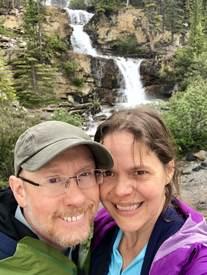Target heart rate?

carrierella
Posts: 109 Member
Can you tell me how to learn what my target heart rate *is* when exercising?
Is there something on MFP that I have not found/seen to calculate it.
Knowing me, I overlooked it.
Carrie
Is there something on MFP that I have not found/seen to calculate it.
Knowing me, I overlooked it.
Carrie
0
Replies
-
Can you tell me how to learn what my target heart rate *is* when exercising?
Is there something on MFP that I have not found/seen to calculate it.
Knowing me, I overlooked it.
Carrie0 -
Here is the Karvonen method:
http://www.briancalkins.com/HeartRate.htm
otherwise it's 220 minus age is the max. So 220-37 = 183 max. So 70% would be 128, 85% would be 156, etc. Generally, it's between 75-85% for cardio benefit and anything over 60% is exercise :bigsmile:0 -
To get your target heart rate, first do your resting heart rate for a minute, then do intense exercise for at least 3 minutes, then take your heart rate for a minute, just like when doing your resting heart rate. Also, it is good to, while your at it, take your recovery heart rate. If you still have questions, just ask!0
-
okay... and then what do you do with all of those numbers!?
Carrie0 -
okay... and then what do you do with all of those numbers!?
Carrie
If you are wearing a HRM or at a gym with HR readers on the equipment then you go for the 75-85% for three workouts a week. If you are do not have that kind of stuff, then go on perceived effort:
http://www.providence.org/oregon/Health_Resource_Centers/Fitness/AskAnExpert_Fitness_Intensity.htm
go for a 15 effort.0 -
This is a tricky one. We can give you the standard formula but it is by defintion inaccurate.
The stnadard formula is 220 less your age to determine your Maximum Heart Rate (MHR). The Maximum Heart Rate (MHR) is to be the highest rate that your heart will beat if being chased by a bear and you are really trying to get out of there.
First the fact that your heart can beat faster or slower at MHR is not a sign of fitness or the lack there of.
Second it assumes that the rate drops by one beat per year. If you remain active that is closer to half beat per year.
Third the starting point (the 220) varies by person.
At 52 years old, my MHR recorded last year was 212 (on a cycling hill climb).
As noted above, there are several reasons that the standard formula is wrong. John Parker in his book the "Heart Rate Training for the Compleat Idiot" and yes Compleat was spelled that way makes it easy to find on searches. for women he uses 207 less half your age as his formula but recommended a test which included four intervals of 100 yard dashes uphill to determine your actual MHR. That made a world of difference for me. Since at 50 by the formula my MHR should have been 170 (making the aerobic threeshold around 110 instead of 140. A hugh difference. 110 in is my recovery zone.
I highly recommend John Parker's book. It is in English and is an easy read (and very understandable)0 -
carrie, you basically get your max heart rate, then you can calculate your target range by multiplying by the percent.
Marywilldiet gave you all the ranges, what you are looking for is to stay within a range when exercising.
for a medium level workout 70 to 75% is pretty good or (128 bpm to 138 bmp). Most non-professional athletes can work safely right up to 85% or so (assuming you are already in SOME kind of shape and have no pre-existing medical conditions) but that can be very taxing at first and will most likely shorten your workout considerably. You usually use a heart rate monitor to work like this, but many machines have HRM's built in, but usually you have to hold a front hand plate to get it which makes it a little harder. Some elipticals have "ski poles" that have them built in though, which is nice for 2 reasons, 1 you work the upper body a little, and 2 it keeps a constant measurement of your Heart Rate.0 -
Here is what I have posted before. I'm copying here again, if you have any questions let me know.
"OK, here's the low down on the heart rate that you should work out at. It's a lot of information, so bear with me on this one. It use to be that the rule of thumb is age divided by 2, then 220 minus this number. But this isn't really accurate because this old formula is based on males that are non-athletic. If you're female and considered "fit", then you actually take 211 and minus this number. If you're female and "not athletic", meaning have not worked out in a long time, you will take 226 and minus this number. Since I don't know you, you will have to make the determination if whether you are "fit" or "not athletic".
So let's say that you are "fit". You will take your age divided by 2, then 211 minus this number. This will give you your maximum heart rate at 100%.
Based on this number you will figure where 60%, 70%, 80% and 90% is.
Where should you train in?
Fat Burning -The optimal target to get to for fat burning is between 60 and 70%, BUT you must do this for a long period of time, such as 1 hour or more. If you go slow and keep your heart rate here and go for over 1 hour of training, you will be in the best zone for fat burning.
Cardiovascular Improvement - Between 70% and 80%. In this aerobic zone your body will transfer oxygen to your muscles, heart and lungs, which will push the carbon dioxide out which will improve your overall health. Depending on the level of your health, you will want to be here about 45 minutes to 1 1/2 hours.
Anaerobic State - between 80% to 90%. When you work in this zone, your body is no longer burning fat, but burning glycogen instead. When you burn glycogen you will begin to build lactic acid, that's when you develop cramps in the muscles.
Red Line Zone is anything beyond 90%. This is where athletes get their speed, you can only train here for minutes at a time, this is where athletes develop their "fast twitch" muscle fibers which allows them to have explosive power, but the explosive power last for only seconds.
Now decide what your goal is, most will either be in "Fat burning" or "Cardio Improvement". Then work with your heart rate within those areas.
It is quite complicated, so PM me if you want me to help you figure out your target heart rate."0
This discussion has been closed.
Categories
- All Categories
- 1.4M Health, Wellness and Goals
- 398.4K Introduce Yourself
- 44.7K Getting Started
- 261K Health and Weight Loss
- 176.4K Food and Nutrition
- 47.7K Recipes
- 233K Fitness and Exercise
- 462 Sleep, Mindfulness and Overall Wellness
- 6.5K Goal: Maintaining Weight
- 8.7K Goal: Gaining Weight and Body Building
- 153.5K Motivation and Support
- 8.4K Challenges
- 1.4K Debate Club
- 96.5K Chit-Chat
- 2.6K Fun and Games
- 4.7K MyFitnessPal Information
- 17 News and Announcements
- 21 MyFitnessPal Academy
- 1.5K Feature Suggestions and Ideas
- 3.2K MyFitnessPal Tech Support Questions




